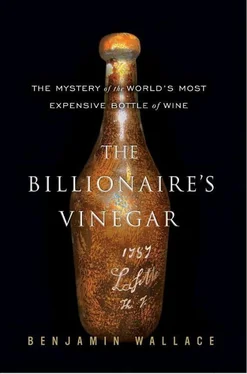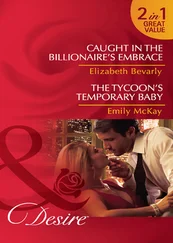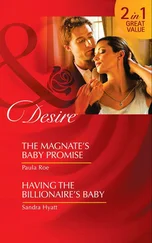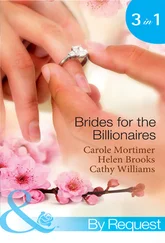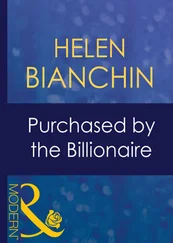“So, the bottle’s broken,” the Times reporter said.
Gloria did a double take. “Excuse me?” she said.
“Bill broke the bottle,” Goldberg repeated.
At first Gloria had a hard time believing that her husband could have left without her, but as she continued to look for him without success, it began to sink in. This was a problem. She had no money. She didn’t even have the ticket to retrieve her fur coat. Somewhat embarrassed, she had to borrow five dollars from a tablemate for a taxi. Fortunately, her husband had at least had the presence of mind, in his rushed departure, to leave her coat-check ticket with the attendant.
Gloria took a cab home, and on the way, a news report came on the radio about what had happened. She arrived home and, understandably annoyed, allowed herself an I-told-you-so. But she knew how bad it felt to break something. A few years earlier she had been removing her silver chest from its hiding place inside the wine closet when she accidentally broke an 1874 Lafite. She and Bill had literally lapped it up off the floor. He had been understanding then, saying, “Accidents happen.”
Now she found her husband “bereft,” as she later put it. “Bill was inconsolable.” Arriving home, Sokolin had gingerly removed the bottle from its carrier. Only about five ounces of wine, or 20 percent, remained. He went into the kitchen, where the walls were covered in paper, designed by Gloria, featuring a repeating pattern of signatures of great modern French chefs. Paul Bocuse. Jean Troisgros. Alain Chapel. Sokolin poured a small glass for himself, then put the rest of the wine in a small plastic container, which he put in the freezer. He tasted what was in his glass. It was recognizable as wine, but by no means tasted good. He put the empty bottle on a table in the living room.
At midnight, with the arrival of April 25, he turned fifty-eight. Forty minutes into Sokolin’s birthday, Howard Goldberg, the Times reporter who had made off with a piece of the bottle, telephoned, eager to secure his scoop. He asked if Sokolin had been drunk. Sokolin said he’d only had a single glass of Champagne and hadn’t finished any of his glasses of Bordeaux.
“I did something terrible,” Sokolin told Goldberg. “I’m very unhappy. I was in shock. I committed murder.”
The next morning, Tim Littler was staying with friends in Geneva when his host knocked on his bedroom door and said a reporter was calling from the New York Times . Littler didn’t think anyone knew where he was, so he wasn’t sure how the reporter had tracked him down, but he took the call. Goldberg delivered the bad news. At first, Littler thought it must be an April Fool’s joke, but it was already the fourth week of the month, so he quickly gave up on that idea. Several more newspapers called that day.
Littler wasn’t worried about the money. His attitude was a shopkeeper’s: you break it, you buy it. At first he thought, knowing Sokolin, that it might be a publicity stunt. But once he learned of the precise pattern of breakage, Littler ruled out that theory. If the bottle had fallen on the ground and shattered, that would be one thing, but no one could intentionally and cleanly puncture such an old bottle.
The next several days were a blur of media attention. Sokolin walked to a TV studio, bottle in hand, to appear on Regis Philbin’s show. “Murder at Four Seasons” was the headline in U.S. News & World Report. People went with “Oops!” and dubbed Sokolin’s misfortune “the world’s most expensive puddle.” The New York Post blared: “Grapes of Wrath: Clumsy Vintner Breaks a 519G Bottle of Wine.” For Fleet Street tabloids, the episode served as a platonic illustration of Yank barbarism. “What a Plonker!” screamed one, while another tossed off a “Thought for Today: There’s only one thing worse than an American with no taste: One who buys it, then drops it.”
Cartoonists had a field day. “Okay, stand back,” a man said to a crowd gathered around a puddle in one cartoon, “and let it breathe.” In another, a man opined, of a splotch on the floor, “It’s a pleasant stain, I think, but not a great one.” Paul Kovi, at the Four Seasons, sent Sokolin a bill for the $360 it had cost the restaurant to have the rug cleaned. Sokolin ignored it. His feeling was that Kovi had gotten about “ten or twenty million dollars’” worth of free advertising out of his gaffe. (It would be dwarfed, seventeen years later, when casino developer Steve Wynn put his elbow through a $139-million Picasso.)
When the reporter from People came to his home, Sokolin reached for the bottle, which still stood on the table where he had set it down, and almost knocked it over. Sokolin put his hand to his chest as the bottle swayed, but it remained standing. Sokolin retrieved the plastic container from the freezer and let the reporter smell it. It “looked like chocolate-brown goo and emitted an intense aroma not unlike that of stewed prunes,” the reporter wrote.
“You think I did it on purpose, don’t you?” Sokolin said to the reporter, who concluded that it had been a true accident. Two of the key questions muttered by suspicious colleagues after Sokolin broke the bottle had ready answers: the level of wine was so high, and the seal new, because of the recent recorkings by Margaux and Whitwhams.
Sokolin by now was embracing his fifteen minutes—mugging for the camera, bugging his eyes out, and holding the bottle forth defiantly. He said the bottle had been “worth maybe $10 million or maybe more.” He and Gloria, a real-estate broker, found themselves invited to social gatherings that previously would have eluded them. It wasn’t clear whether they were guests or entertainment. At one high-powered dinner party, the host introduced Sokolin as “Butterfingers.”
The New York Times saw a morality tale in what had happened, publishing an editorial that read, in part, “Everyone who has saved a perfume for a worthy occasion and found its lilies have festered by the time she gets around to opening the bottle knows what it is to be a William Sokolin.” A William Sokolin! He had become a cautionary archetype. The lesson, the Times concluded, was that wine is for drinking rather than saving.
A month after breaking the bottle, Sokolin removed the frozen wine from his freezer and defrosted it. No decanting, no ceremony. He just drank it from a glass. A strange thing had happened in the last month. “It was good, but it wasn’t wine,” Sokolin recalled. “It was grape juice.” The freezing had removed the alcohol, and with it the impurities. At least that was Sokolin’s take.
Sokolin says he asked Hardy Rodenstock for a replacement bottle, and Rodenstock replied that it would cost $800,000. “You’re crazy,” Sokolin told him. The insurance company Frank Crystal & Co. eventually made out a check to “Whitwhams and William Sokolin” in the amount of $197,625 and dated June 7, 1989. The money would go to Tim Littler, who had intended to reclaim the bottle in June, since he had an interested buyer in Japan.
Soon after, Littler and Michael Broadbent were chatting at the Imperial Hotel in Tokyo, when a man approached, ringing a small bell. Littler and Broadbent were old friends, and Whitwhams handled Christie’s shipping and customs clearance in Japan. Broadbent was doing an auction there. “Mr. Littler,” the bell-ringer said, “you have a fax.” It reported that the insurance check had arrived.
“I guess we’ve lost the record,” Broadbent said.
CHAPTER 11

THE DIVINER OF WINES
IN THE LATE 1980s, HARDY RODENSTOCK TOLD HIS friend Georg Riedel that he wished to create his own line of mouth-blown wineglasses. Riedel was the tenth generation in a remarkable glassmaking dynasty. It had begun in the Bohemian forest three centuries before and, after World War II, relocated to the Alpine Austrian village of Kufstein. Georg’s father, Claus, had a simple, brilliant insight: the shape of a glass—the size of the bowl, its curvature, the diameter of the rim—affects how a wine smells and tastes. Claus produced a glass for each of the classic wine regions, including Bordeaux, Burgundy, and Châteauneuf-du-Pape, in the Rhône Valley. They were beautiful and functional. The grand cru Burgundy glass was enormous, with a flaring lip. The Museum of Modern Art in New York City acquired one for its permanent collection.
Читать дальше
